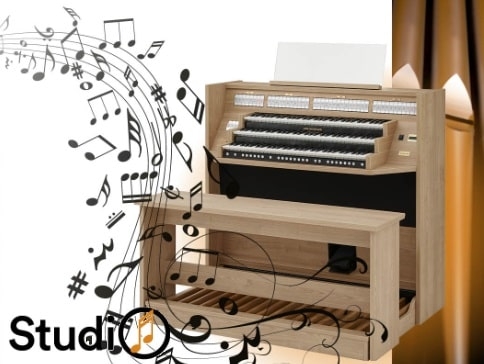New Johannus Studio 260 / Studio 360 / Studio P360
With new models, you will naturally be very curious about recent developments and improvements. We would like to explain this point by point:
1. Samples of real pipe organs
The Johannus Studio models are specially designed to offer organ lovers an authentic and diverse playing experience. These beautiful instruments feature samples from various pipe organs, allowing them to perfectly recreate the unique sounds of these historic instruments.
Carefully selected samples from famous pipe organs have been used for each sound style in the Studio models. Below is an overview of the organ styles and their corresponding pipe organs from which the samples come:
A. Romantic: Vater-Müller organ, Oude Kerk Amsterdam - This beautiful organ is known for its warm and rich romantic timbre, making it ideal for creating an atmospheric and nostalgic musical experience.
B. Baroque: Silbermann organ, Katholische Hofkirche Dresden - The impressive Silbermann organ is known for its clear and balanced Baroque sounds. This gives the Studio models a lively and energetic sound typical of the Baroque period.
C. Symphonic: Adema organ, Raalte (NL) and Cavaillé-Coll organ, Paris - These two majestic organs are known for their lush and powerful symphonic sounds, which enable the Studio models to perform grand and compelling musical works.
D. Historic: Hinsz organ, Bovenkerk Kampen (NL) - The historic Hinsz organ is famous for its authentic and distinctive sound, offering the Studio models a deep connection to the past and enabling players to revive centuries-old music.
2. Style variable Disposition
The style variable disposition is an innovative function in the Johannus Studio models that has been carefully adapted to the different organ styles. The purpose of this is to reproduce the unique, characteristic sounds of each style in a lifelike manner. This is reflected in the design of the organ, where some register buttons have a double name engraved. This allows one register to represent multiple sounds, depending on the style chosen.
For example, in the symphonic style one register produces a "Flute Harmonique" sound, while in other styles that same register represents a "Quintadeen". This enables the organ to display characteristic registers of certain styles and offers organists the opportunity to play specific music with a suitable registration.
This clever approach even brings Kampen's famous carillon to life, and the baroque bank has a full principal choir on the swell. The style variable disposition is thus an excellent tool for creating authentic and inspiring organ music, regardless of the specific style the organist wishes to explore.
3. Convolution reverb
The use of convolution reverb and its powerful processor reproduce 48,000 reflections per second, leading to a lifelike reverb experience. Moreover, the Studio 360 also gives you access to 12 different types of reverb to set the organ to your liking.
4. Ambiance Function
The ambience function is a unique feature previously available in live organs and now also integrated in the Johannus Studio models. This feature allows organists and listeners to change their listening position in relation to the organ pipes, at the touch of just one button. This allows them to fully personalise the acoustic experience and adapt it to their preferences.
Several listening positions are available to choose from, so everyone can find the optimal listening experience:
- Close to the pipes: As a listener, when you stand close to the organ pipes, you experience an intimate and direct sound. You can clearly perceive the individual voices and nuances of the instrument. This is ideal for people who want to immerse themselves in the details of the music.
- A little further away: Placing the listening position a little further away from the organ pipes gives a more balanced and harmonious sound experience. The sound has room to blend and creates a pleasant combination of directness and spaciousness. This is perfect for those who like to enjoy a balanced and coherent listening experience.
- At the very back of the church: When the listening position at the very back of the church is selected, you experience the impressive acoustics and reverberation typical of organ sound in large church halls. This makes for an overwhelming and majestic listening experience, ideal for those who like to fully experience the grandeur of organ music.
5. Solo voices
In addition to the extensive disposition, each organ has two solo voices, a pan flute and a trumpet. Even in the Studio 260, this is now available, where previously it was only applied to the organs with three manuals. The solo voices can be used separately or combined with other stops, depending on your musical goals and taste, and are intended to add extra expressiveness and variety to your organ playing.
The models
The new Johannus Studio series comes in three models. The Studio 260 is a two-manual model, the Studio 360 an organ with three manuals and the Studio P360 features three manuals and comes in a positive case. Each organ is available in four colours:
Studio 260: Light Riverside, Nautilius Teak, Charcoal Black, Wenge
Studio 360: Light Riverside, Nautilius Teak, Charcoal Black, Wenge
Studio P360: Light Riverside, Nautilius Teak, Charcoal Black, Wenge

